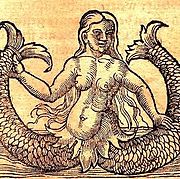Water woman


Water woman refers to a figure or a motif in legends , myths and fairy tales of numerous cultures. A characteristic feature of the water woman is her positive attitude towards people: As a “water mother” she gives life, protection and blessings, as a “water bride” she marries a human bridegroom and gives him her love. The water woman is to be distinguished from other female aquatic beings, in particular
- Mermaids : these water spirits have a threatening aspect (their counterpart is the Aquarius )
- Mermaids : these "fish women " have an aspect of need of salvation
In the case of many aquatic creatures, a clear assignment to one of the categories is not possible (for example “Die Schöne Lau ” - also “die arge Lau” - by the German poet Eduard Mörike ); In addition, the categories are often confused and used synonymously , especially in recent times .
Other names for water women fish Miss , Meerfräulein (see the crest shape of the mermaid ) and Melusines (see the legendary figure of Melusine ).
shape
Like mermaids and mermaids, many water women are described as hybrid beings (chimeras) with a human upper body and scaly fish tails. Often, however, they also have human shape or that of frogs , swans and other aquatic animals.
Meaning as a motive for life
In the motif of the water woman, two classic life motifs are united in cultural history: On the one hand, the woman as the giver and sustainer of life, as an anima in the sense of Jung's theory of archetypes . On the other hand, there is the motif of water, from which not only all life originates in evolutionary history, but which is also an indispensable prerequisite for life as food for plants, animals and people. The counterpart to the water woman is the mermaid as the union of water and death - also an expression of the anima, but in the sense of the "killing", the "devouring" mother.
According to the analytical psychologist Carl Gustav Jung (1875–1961), the water woman - like mermaid and mermaid - is an expression of the anima as a form of the depth psychological mother archetype . However, the positive aspect of the “loving mother” is clearly expressed by the water woman.
Well-known water women
Water women appear in large numbers in the mythologies of ancient peoples, for example the fish-tailed moon goddess Derketo was worshiped in the Near East . The Indian deity Vishnu , the “world preserver”, was sometimes depicted as a four-armed woman with the abdomen of a fish. In Chinese mythology , the beneficial work of the healing " dragon women" living on the bottom of rivers and lakes was extolled.
In Greek mythology , the water woman type is represented in particular by the Nereids (50 daughters of Nereus and Doris ) and the Oceanids (daughters of Oceanus and Tethys ): friendly and cheerful sea nymphs who delight sailors. There are also the naiads who live in springs and rivers . Water women were also part of the retinue of the sea god Triton .
In a broader sense, the sea goddesses of all cultures are also water women, above all the love goddess Aphrodite ( Venus in Roman ), who is represented in human form , the "foam-born", who combines the maternal and spousal aspect of the water woman. It was immortalized ideally by the Italian Renaissance painter Sandro Botticelli in his painting The Birth of Venus , in which the goddess rises from a shell. There are different Chinese sea goddess as Tin Hau or Matsu , which have a thousand eyes and arms to the sailors the way across the sea, the Javanese sea goddess Ratu Kidul , the Inuit -Meeresgöttin Sedna , the Brazilian Yemayá or the Baltic goddess Jūratė (derived from Jūra , "Lake").
The mermaid riding on a dolphin , which the elf king Oberon saw in Shakespeare's comedy A Midsummer Night's Dream from a promontory, also bears all the traits of the benevolent, benevolent water woman, her "sweet harmonies [...] make the indignant sea obedient" and even the Listen to the stars reverently.
More recent stories and fairy tales tell of water women who, as godmothers, offer an orphan protection from the adversities of life ( The young countess and the water woman in Swabia), secretly weave, spin and bake in people's homes ( Das Bleilot im Schwarzwald; Das Washer women in Austria), or approaching their human lover in the form of frogs or swans ( The Swan Princess in Poland; The Pearl String in Austria; Tsarina Frog in Russia).
See also
- River deities (many in the Indo-European language area)
- Siren (hybrid woman-bird)
- Mermaiding (swimming sport)
literature
- Beate Otto: Underwater literature: From water women and water men (= Epistemata: Series Literary Studies. Volume 348). Königshausen & Neumann, Würzburg 2001, ISBN 3-8260-1971-7 ( reading sample in the Google book search).
- Barbara Stamer (Ed.): Fairy tales of mermaids and water women. Fischer-Taschenbuch, Frankfurt 1987, ISBN 3-596-22873-5 .
Individual evidence
- ^ Heinrich Grimm: New contributions to the "fish literature" of the XV. to XVII. Century and through their printer and bookkeeper. In: Börsenblatt for the German book trade - Frankfurt edition. No. 89, November 5, 1968 (= Archive for the History of the Book Industry. Volume 62). Pp. 2871-2887, here p. 2886.
